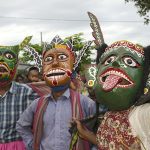
Sunil Discover the enchanting world of Sunil who breathes life into history and nature through the delicate strokes of watercolors. Each piece is a captivating
In a world of mass-produced objects, Dhokra stands out as a celebration of the handmade and the unique.

Dhokra is a traditional lost wax metal casting technique used by the tribes of Bastar, located in the central Indian state of Chhattisgarh. The art is practiced by Ghadwa community hence it is also known as Gadwa art. Gahdwa literally means Galna which means to melt. The art form dates back to over 4000 years. Dancing girl of Mohenjodaro is one of the earliest known artifact made using lost wax technique.

The process of Bastar Dhokra involves using the lost-wax casting method, where a wax model of the object is created, coated with clay, and then heated until the wax melts and drains away, leaving a mold that is then filled with molten metal. This technique results in intricate and delicate metal sculptures with a unique texture and organic feel. Common metals used are alloy of bronze, brass, nickel and zinc.
The artisans of Bastar use locally sourced materials such as wax, clay, and metal, and the finished products are made using traditional tools and techniques passed down from generation to generation. The objects created through this technique range from utilitarian items like cooking vessels, musical instruments, and jewelry to decorative sculptures and figurines.
One of the most striking features of Bastar Dhokra is its asymmetrical beauty, where no two pieces are exactly alike. This gives each object a unique character and makes it a true one-of-a-kind piece.
The tradition of Bastar Dhokra is deeply rooted in the culture and daily life of the tribal people of Bastar. The art form is not only a source of livelihood for the artisans, but also a means of preserving their cultural heritage and passing it down to future generations.
In recent times, Bastar Dhokra has gained recognition and popularity both nationally and internationally, with several organizations and individuals working to revive and promote the dying art form. However, despite its growing popularity, Bastar Dhokra remains a fragile and endangered craft, with many challenges faced by the artisans, including the lack of access to raw materials, traditional tools and techniques, and market opportunities.
Do let us know in comments what art from you like most and if you are aware of any endangered or locally practiced art forms.
Image credit:

Sunil Discover the enchanting world of Sunil who breathes life into history and nature through the delicate strokes of watercolors. Each piece is a captivating

The world of art is a vast and mesmerising realm that encapsulates the essence of cultures, histories, and traditions. One such unique mandala art is treasure trove of artistic brilliance is Maithili art, with its jewel being the exquisite Madhubani painting. Originating in the Mithila region of Bihar, India, Maithili art and Madhubani painting are more than just strokes on a canvas; they are living expressions of a rich heritage and a vibrant cultural narrative.

The wooden mask of Kushmandi is hand-carved from a single piece of wood by skilled artisans. The mask is typically painted in bright colors with intricate designs and patterns. The masks are generally large and cover the face of the wearer completely. They are often decorated with feathers, shells, and other embellishments to add to their aesthetic appeal.